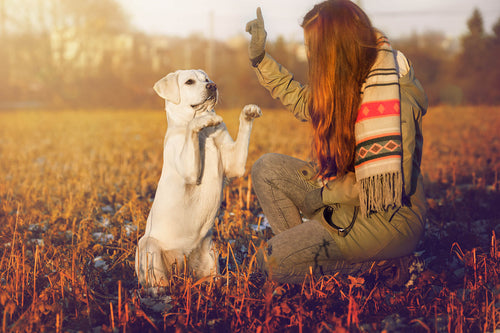
Building Bonds: Teaching Children How To Interact Safely With Dogs
Share
It's a given – dogs bring a unique blend of joy, loyalty, and energy to a family. However, like any relationship, it requires nurturing and understanding to ensure the safety and happiness of all parties. With dog bites representing a real risk, particularly to little ones who may not yet understand how to interact with dogs, it becomes imperative to equip them with the right tools and knowledge. This article aims to serve as a beacon for dog parents in guiding their children to forge safe and respectful relationships with their pet dogs, emphasizing not just animal welfare, but the wellness of the family as a whole.

Understanding Dog Body Language
Mastering the art of understanding dog body language is pivotal in preventing dog bites and ensuring safe interactions between children and their canine companions. Dogs convey their emotions and intentions through various signals such as tail wagging, barking, and body posture. However, it's crucial to debunk some common misconceptions; for instance, a wagging tail doesn't always signify a friendly pooch - context is key.
-
A stiff wag can suggest heightened alertness, whereas a loose wag typically indicates a relaxed attitude.
-
When a dog exposes their teeth or growls, it's often a sign of discomfort, urging us to give space.
-
Reading dog body language accurately teaches children when it's appropriate to approach dogs.
Tuning in to these non-verbal cues allows children and adults alike to read body language effectively, fostering a harmonious environment for everyone involved.

Teaching Consent and Respect for Animals
Instilling in children the principles of animal consent and respect for animals is paramount. Just like the social cues between humans, it's essential for children to understand that not every pet dog is in the mood for roughhousing or a belly rub. To promote animal wellness, we must teach youngsters to seek a sort of permission from our four-legged companions. This begins with simple actions, such as observing the dog's body language and allowing the dog to approach first.
-
Encourage children to let the dog sniff their hand, which should be presented with a flat palm and fingers held together.
-
Teach them the proper petting techniques: gentle strokes along the back and avoiding sensitive areas unless the dog shows comfort.
-
Highlight the importance of never approaching a dog from behind or startling them, which can lead to unnecessary stress or even aggression.
By fostering this level of understanding and respect for dogs, we guide children in forming compassionate and secure relationships with their canine friends.

Pet Safety Tips for Children
When introducing children to the world of pet dogs, imparting dog safety knowledge is paramount. Here's a concise guide to ensure their interactions are both pleasant and secure:
-
Approach with Care: Teach children to always ask permission from the dog's owner before approaching. Encourage them to greet slowly, allowing the dog to sniff their hand first, which is a friendly canine hello.
-
Gentle Touch: Demonstrate how to pet dogs gently, avoiding sensitive areas and noting the difference between pet play and agitation.
-
Supervised Interactions: Always supervise kids around dogs, especially with adult dogs and puppies they're not familiar with, to prevent misunderstandings that could lead to injury.
By embedding these ground rules, children can learn to be good teachers and compassionate companions to their four-legged friends, enhancing the strength of their growing bond.

Engaging Activities for Learning
Diving into the world of dogs with your children should be as playful and enjoyable as a game of fetch. Engaging activities are a fantastic way to sprinkle some learning fun into lessons about dog safety and respect. These interactive experiences can turn important safety principles into memorable playtime adventures.
-
Role-Playing: Simulate scenarios where your child meets a new dog. Practice how to approach and when to offer a sniff hand. This hands-on approach helps children understand proper greetings and interactions.
-
Safety Games: Games like "Red Light, Green Light" can teach kids when to approach dogs and when to stay still, promoting patience and attentiveness around our four-legged friends.
Integrating these lively exercises into your child's routine not only reinforces respect for our canine companions but also cements vital safety habits, making every new dog encounter a positive one.

Encountering Other Dogs
When venturing into the great outdoors or urban jungles, children will inevitably cross paths with other dogs. It’s a scenario that requires a spoonful of caution and a pinch of know-how. Let’s cook up some safety tips:
-
Sniff Out the Situation: Teach your children to always look for the owner’s nod of approval before approaching a dog. This small gesture of respect can prevent uncomfortable situations for everyone involved.
-
Service Dog Savvy: Service dogs are working professionals with a job to do. Educate your little ones on the importance of not distracting these canine heroes, ensuring both the dog and their handler remain safe and undisturbed.
-
Respect Dogs' Space: Like their human counterparts, dogs need personal space. Use games to teach children safe distances when encountering dogs, reinforcing the idea that not all furry friends are up for a cuddle.
These nuggets of wisdom will guide your child in forming polite and careful interactions with other dogs, whether during a stroll in the park or while on a family getaway to a pet resort.

Boarding and Pet Resort Safety
When considering boarding or a stay at a pet resort, safety should be the top priority. Not all facilities are created equal, and it's imperative to do your homework to ensure a positive experience for both your child and your dog. Here are some tips for navigating these environments:
-
Research and select a reputable facility with transparent safety policies and a history of positive reviews.
-
Ensure the staff are trained in dog behavior and that they can recognize signs of stress or discomfort in pets.
-
Visit the facility with your child beforehand, teaching them how to be gentle with dogs in this new setting.
-
Discuss with your child that they must not scream or run away from dogs in the facility, as these actions can provoke unexpected reactions from unfamiliar dogs.
By providing these guidelines, you can help your child understand the boundaries and foster a safer environment during your dog's stay at a boarding or pet resort, ensuring peace of mind for everyone involved.
Related Posts
-

9 Life Lessons from My Four-Legged Friend
Forget classrooms, wag more tails! Our furry friends are our wisest teachers.
Ever heard that the best teachers have four legs and wagging tails? I couldn't agree more! Our canine companions have a special way of imparting wisdom that surpasses even the most learned humans. From their unwavering love to the joy of the present moment, dogs are like seasoned professors in the school of life.
-

How To Speak Dog: Decoding Your Dog's Body Language For a Stronger Bond
This guide will help you understand your dog's body language and build a stronger bond with them. Dogs use nonverbal cues to express their emotions, desires, and needs. By learning to interpret these cues, you can become a fluent speaker of 'dog' and improve your relationship with your pet.
-

How to Train a Puppy Using Positive Reinforcement
If you're thinking about inviting a new pup into your life, you're probably wondering how you should train your dog so he's well behaved and will listen to your commands. Positive reinforcement is all about encouragement and praise, so the training process is a pleasant one. Most dogs respond extremely well to this method of training and learn quickly.
-

How to leash train a puppy.
-

What size collar is right for your doggie? Collar Size Chart for Dogs
Beyond buckle clicks: The ins and outs of comfy dog collars. Slipping on a collar might seem simple, but there's more to it than meets the eye. Learn how to ensure a snug yet comfy fit for your pup!









